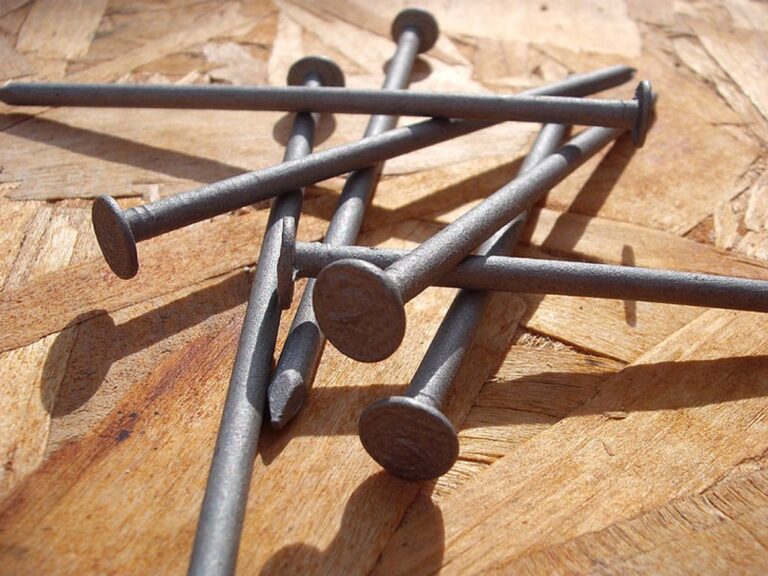“Top Picks: Which Nails Are the Best?”
When it comes to construction and woodworking projects, choosing the right nails is crucial for ensuring the strength, durability, and longevity of the finished product. With a wide variety of nail materials, types, sizes, coatings, and innovative technologies available, it’s important to understand the unique characteristics and applications of each. In this article, we will explore the top picks for nails, providing a comparative analysis of nail materials, specific applications of nail types, considerations for nail size and coatings, and the latest innovations in nail technology.
Key Takeaways
- Understanding the strengths and applications of different nail materials is essential for choosing the right nails for your project.
- Selecting the appropriate nail type based on specific applications ensures optimal performance and functionality.
- Matching nail size to material thickness and understanding gauge and shank diameter are key considerations for successful nail usage.
- Coatings and treatments can significantly enhance nail performance, providing protection against rust, chemical damage, and improving adhesion for various tasks.
- Innovations in nail technology, such as pneumatic nails, screw nails, and plastic strip nails, offer improved speed, efficiency, and functionality for modern construction and woodworking projects.
Understanding Nail Materials: A Comparative Analysis

Steel Nails: Strength and Versatility
Steel nails are renowned for their exceptional strength and versatility, making them a staple in construction and woodworking projects. These nails are made from high-carbon steel, which provides the durability needed to withstand significant weight and stress. Versatility is a key attribute of steel nails, as they can be used in a variety of applications, from framing to cabinetry.
When selecting steel nails, it’s important to consider the specific requirements of your project. For instance, thicker gauges are ideal for heavy-duty tasks, while finer gauges are better suited for delicate work. Here’s a quick guide to help you choose:
- Thick Gauge: Structural projects, heavy framing
- Fine Gauge: Trim work, fine woodworking
Tip: Always pre-drill holes when working with hardwoods to prevent splitting, which can compromise the integrity of your work.
Steel nails also come in different finishes to cater to various environmental conditions. For example, a galvanized finish can offer additional rust resistance for outdoor projects. Remember that the right nail can make all the difference in the longevity and success of your construction endeavors.
Stainless Steel Nails: Corrosion Resistance for Outdoor Use
When it comes to outdoor construction or projects in marine environments, stainless steel nails are the superior choice. Their inherent resistance to rust and corrosion makes them ideal for use in areas exposed to moisture and salty air. Unlike other materials that may degrade over time, stainless steel maintains its integrity, ensuring a long-lasting hold.
Stainless steel nails come in various grades, with 316-grade being particularly noteworthy for its durability in harsh conditions. For example, a pack of 2 in. x 15-Gauge 316 stainless steel nails offers a jam-free guarantee and a lifetime guarantee against rust and corrosion, making them a reliable option for demanding applications.
Tip: Always match the grade of stainless steel nails to the environmental conditions to maximize their lifespan and performance.
While they may come at a higher initial cost compared to other nail materials, the long-term benefits of reduced maintenance and replacement often justify the investment. Selecting the appropriate size and gauge for your project is crucial to ensure the nails can handle the load without bending or breaking.
Aluminum Nails: Lightweight and Rustproof
Aluminum nails are a popular choice for projects where weight and rust resistance are critical considerations. Their lightweight nature makes them ideal for use in items that are sensitive to additional weight, such as thin siding or delicate trim work. Moreover, aluminum’s inherent rustproof qualities ensure that these nails remain durable in environments where moisture is present.
When selecting aluminum nails, it’s important to consider the specific requirements of your project. For instance, they are not recommended for load-bearing applications due to their lower shear strength compared to steel nails. However, for non-structural tasks, they offer a reliable and long-lasting fastening solution.
Tip: Always pre-drill holes when working with aluminum nails to prevent wood splitting, especially in hardwoods or near the edges of a workpiece.
Here’s a quick guide to the advantages of using aluminum nails:
- Rustproof: Ideal for outdoor projects and in areas with high humidity.
- Lightweight: Less stress on structures, perfect for delicate assemblies.
- Non-magnetic: Suitable for projects where magnetic interference is a concern.
- Softness: Easier to drive into materials without pre-drilling, except in certain cases as noted above.
Copper Nails: The Choice for Longevity
Copper nails are renowned for their exceptional longevity, making them a preferred choice for projects where durability is paramount. Unlike other metals, copper resists corrosion in various environments, including coastal areas where salt spray is common. This natural resilience makes copper nails ideal for use in roofing, especially for historic restorations or high-end construction where the aesthetic appeal of copper is also a consideration.
When selecting copper nails, it’s important to consider the specific requirements of your project. For example, the thickness of the material being fastened will dictate the length of the nail needed. Here’s a quick guide to help you choose the right copper nail for your task:
- Roofing: Longer nails to ensure a secure hold through layers of shingles and sheathing.
- Decorative work: Shorter nails that minimize visual impact while still providing a strong hold.
- Marine environments: Copper nails with a larger shank diameter to combat the harsh conditions.
Tip: Always pair copper nails with copper or stainless steel fixtures to avoid galvanic corrosion, which can occur when copper is in contact with dissimilar metals.
Copper’s natural patina is not only protective but also adds a touch of elegance that evolves over time. As the metal ages, it develops a greenish hue known as verdigris, which many find aesthetically pleasing. This characteristic, combined with the metal’s inherent durability, contributes to copper nails being a top pick for projects that aim to stand the test of time.
Nail Types and Their Specific Applications

Finish Nails: For a Seamless Look
Finish nails are the unsung heroes when it comes to woodworking and trim work. Their slender shank and small head allow them to be driven below the wood surface, leaving a minimal footprint that can easily be filled and painted over for a seamless finish. Ideal for delicate trim and molding, these nails provide strong hold without splitting the material.
- When selecting finish nails, consider both the length and the gauge to ensure they are appropriate for the task at hand. The length should be at least three times the thickness of the material being nailed to provide adequate hold.
Tip: For best results, use a nail set to drive the finish nail below the surface without damaging the surrounding wood.
Finish nails come in a variety of sizes and gauges, making them versatile for different applications. Here’s a quick reference guide:
- 6d (2") – For light trims and moldings
- 8d (2.5") – Commonly used for door and window casings
- 10d (3") – Suitable for thicker trim boards
Remember, the right finish nail can make all the difference in achieving a professional and polished look in your woodworking projects.
Common Nails: The All-Purpose Solution
Common nails are the quintessential fasteners in the world of construction and DIY projects. Known for their versatility, these nails have a wide head, thick shank, and a diamond point, making them ideal for rough framing and construction where strength and holding power are paramount.
- Durability* is a key feature of common nails, often made from zinc-plated steel to ensure strength. They are designed with a larger shank to enhance this attribute, although this makes them unsuitable for use with nail guns due to the potential for jamming. Here’s a quick guide to common nail sizes and their typical applications:
- 2d (1 inch): Picture hanging, small trim
- 8d (2.5 inches): Framing, sheathing
- 16d (3.5 inches): Framing, structural work
Tip: When selecting common nails, consider the thickness of the materials you are joining. A good rule of thumb is to choose a nail that is three times longer than the thickness of the thinner material.
While common nails are a reliable choice for many projects, they are not recommended for outdoor use where corrosion resistance is needed. For such applications, stainless steel or galvanized nails would be more appropriate.
Masonry Nails: Anchoring to Concrete and Stone
Masonry nails are the go-to choice for attaching wood to masonry materials. They are made of hardened steel and have fluted shafts that enhance their holding power. When working with masonry nails, it’s crucial to select the right type for the material and the load it needs to support.
- For light-duty applications, such as attaching furring strips, a shorter nail may suffice.
- Medium-duty projects, like securing framing members, require longer nails that can penetrate deeper for added stability.
- Heavy-duty tasks demand the most robust masonry nails, capable of anchoring substantial loads.
Tip: Always wear safety goggles when hammering masonry nails to protect your eyes from flying debris.
Remember, the correct installation of masonry nails involves drilling a pilot hole slightly smaller than the nail diameter. This ensures a snug fit and maximizes the nail’s holding power. For best results, use a hammer drill and a masonry bit for the pilot hole, and drive the nail straight to avoid bending.
Roofing Nails: Ensuring Durability Against the Elements
Selecting the right roofing nails is crucial for a roof that can withstand harsh weather conditions. These small but pivotal elements must be chosen with care to ensure they fortify roofing materials against the relentless forces of nature. Galvanized steel or other corrosion-resistant metals are commonly used for roofing nails to prevent rust and extend their lifespan.
Roofing nails come in various sizes and types, each designed for specific roofing materials and applications. For example, smooth shank nails are preferred for standard shingle installation, while ring shank nails offer extra grip strength for high-wind areas.
Always choose the appropriate nail length for the roofing material to prevent nail pops and ensure a secure fit.
It’s essential to match the nail length to the thickness of the roofing material. Here’s a quick guide to help you select the right size:
- 1" nails for thin shingles or membranes
- 1 1/4" to 1 1/2" nails for standard asphalt shingles
- 1 3/4" to 2" nails for thicker or layered materials
By paying attention to these details, you can ensure that your roof has the best chance of enduring whatever the weather throws at it.
Size Matters: Selecting the Right Nail Length and Gauge

Matching Nail Size to Material Thickness
When matching nail size to material thickness, it’s crucial to ensure proper fastening and structural integrity. Selecting the right length and gauge is essential for achieving a secure and durable connection. Consider the following guidelines for matching nail size to material thickness:
- Use a table to present the recommended nail length and gauge for different material thicknesses.
- Ensure that the nail length provides sufficient penetration without protruding excessively.
- Select the appropriate gauge based on the material’s density and load-bearing requirements.
Tip: Always test the nail size and gauge on a scrap piece of material to verify the strength and stability of the connection.
Gauge Guide: What the Numbers Mean
When it comes to nail gauge, it’s crucial to understand the numbers and their significance. A higher gauge number indicates a thinner nail, while a lower gauge number signifies a thicker nail. For example, a 16-gauge nail is thicker than an 18-gauge nail. Here’s a quick reference table to illustrate the relationship between gauge numbers and nail thickness:
| Gauge Number | Nail Thickness (in inches) |
|---|---|
| 16 | 0.162 inch |
| 18 | 0.148 inch |
| 20 | 0.134 inch |
It’s important to match the nail gauge to the material thickness for optimal performance. Additionally, consider the shank diameter, as it plays a crucial role in load-bearing projects. A thicker shank diameter provides better support and stability for heavy-duty applications. Remember, the right combination of gauge, length, and shank diameter is key to a successful nail installation.
The Importance of Shank Diameter in Load-Bearing Projects
When it comes to load-bearing projects, the shank diameter of the nail plays a crucial role in determining its structural integrity and load-bearing capacity. The shank diameter directly affects the nail’s ability to withstand shear and tensile forces, making it a key consideration in construction and carpentry.
In load-bearing applications, the shank diameter must be carefully matched to the material thickness and the specific load requirements of the project. This ensures that the nails provide optimal support and prevent structural failure.
For load-bearing projects, it’s essential to select nails with a shank diameter that aligns with the engineering specifications and load calculations. This precision in choosing the right shank diameter is fundamental to the safety and durability of the overall structure.
Tip: Always consult structural engineering guidelines and load tables to determine the appropriate shank diameter for load-bearing projects.
Coatings and Treatments: Enhancing Nail Performance

Galvanized Nails: Combating Rust and Chemical Damage
Galvanized nails are a staple in construction and outdoor projects due to their enhanced durability. The process of galvanization involves coating nails with a layer of zinc, which acts as a protective barrier against rust and chemical damage. This treatment is particularly beneficial in environments where moisture and corrosive elements are prevalent.
Hot-dip galvanizing is the most common method, where nails are submerged in molten zinc to achieve a thick, uniform coating. This method is preferred for its long-lasting protection. For projects that require a more delicate touch, electro-galvanizing offers a thinner coating that is still effective in warding off corrosion.
Tip: When selecting galvanized nails, consider the thickness of the zinc coating. A thicker coating generally means better protection and longevity.
The table below outlines the typical uses and benefits of galvanized nails:
| Application | Benefit |
|---|---|
| Outdoor Structures | Enhanced weather resistance |
| Coastal Projects | Protection against saltwater corrosion |
| Framing | Strong hold in treated lumber |
By choosing the right type of galvanized nail for your project, you ensure a robust construction that can withstand the test of time and elements.
Phosphate Coatings: Improving Paint and Plaster Adhesion
Phosphate coatings are a game-changer when it comes to enhancing the adhesion of paint and plaster to surfaces. This treatment is particularly beneficial for surfaces that will be painted, as it significantly improves the bond between the surface and the paint. The result is a more durable and long-lasting finish, which is essential in areas subject to wear and tear.
The application of phosphate coatings is straightforward, but it’s crucial to ensure proper surface preparation. Here’s a simple guide:
- Clean the surface thoroughly to remove any dirt, grease, or old paint.
- Apply the phosphate coating evenly across the surface.
- Allow the coating to dry completely before proceeding with painting.
Tip: Always follow the manufacturer’s instructions for the best results. Skipping steps or rushing the process can compromise the coating’s effectiveness.
Phosphate coatings not only improve adhesion but also offer a degree of protection against mold and moisture, which can be particularly problematic in bathrooms and other high-humidity areas. By creating a barrier, the coating helps maintain the integrity of the painted surface over time.
Cement Coated Nails: Extra Grip for Framing Tasks
Cement coated nails are a staple in the construction industry, particularly when it comes to framing tasks. The cement coating provides an extra grip that is crucial for ensuring the stability and durability of the frame. These nails are designed to sink into the wood and stay put, resisting the forces that might cause other nails to loosen over time.
When selecting cement coated nails, it’s important to consider the gauge and length appropriate for your project. The thicker the wood or the heavier the load it must bear, the larger the gauge and the longer the nail you will need. Here’s a quick guide to help you choose:
- For light frames: Use 15 to 17 gauge nails, 1-1/4" to 2" in length
- For standard residential framing: Use 8 to 12 gauge nails, 2" to 3-1/2" in length
- For heavy-duty framing: Use 6 to 8 gauge nails, 3-1/2" to 6" in length
Tip: Always ensure that the nail penetrates at least three times the thickness of the material being fastened for optimal hold.
Remember, the right nail can make all the difference in the longevity and safety of your construction projects. Cement coated nails are an excellent choice for those looking for a reliable and strong fastening solution.
Innovations in Nail Technology

Pneumatic Nails: Revolutionizing Speed and Efficiency
Pneumatic nail guns have transformed the construction and woodworking industries with their ability to drive nails at an unprecedented speed. These tools harness the power of compressed air to deliver fast and consistent results, making them a favorite among professionals for their efficiency and reliability.
Ease of use is another significant advantage of pneumatic nails. With a simple press of a trigger, users can sink nails into a variety of materials with minimal effort. This not only speeds up the project timeline but also reduces worker fatigue.
When selecting a pneumatic nail gun, consider the following:
- The type of projects you’ll be undertaking
- The range of nail sizes the tool can accommodate
- The weight and balance of the gun for comfortable handling
- The air compressor requirements
Always prioritize safety when operating pneumatic tools. Proper training and the use of protective gear are essential to prevent accidents.
Innovation in pneumatic nail technology continues to advance, with newer models offering features like depth adjustment, jam clearance, and selective actuation for even greater control and precision on the job.
Screw Nails: Combining the Best of Screws and Nails
Screw nails, often referred to as screw shank nails, offer a unique combination of the sharp point and smooth shank of a nail with the threaded shank of a screw. This design provides superior holding power, making them an excellent choice for applications where both strength and ease of removal are important.
Advantages of Screw Nails:
- Enhanced grip strength compared to regular nails
- Reduced likelihood of wood splitting
- Can be easily removed if necessary
- Ideal for projects requiring frequent disassembly
Tip: When selecting screw nails, consider the material and the project’s load-bearing requirements to ensure optimal performance.
Screw nails are particularly useful in construction projects such as decking and framing, where their ability to withstand heavy loads and resist loosening over time is crucial. Their versatility makes them a valuable addition to any builder’s toolbox.
Plastic Strip Nails: The Future of Collated Fastening Systems
The advent of plastic strip nails represents a significant leap forward in the realm of fastening technology. These nails, which are collated using a strong plastic strip, offer a unique combination of durability and convenience. Not only do they feed smoothly into nail guns, but they also reduce the likelihood of jamming, a common frustration among professionals.
Ease of use and efficiency are at the forefront of plastic strip nail design. With the ability to hold more nails per strip compared to traditional paper collated nails, they allow for longer periods of work without the need for reloading. This is particularly beneficial in high-paced construction environments where time is of the essence.
Tip: Always ensure that the nail gun is compatible with the type of collated nails being used to avoid damage to the tool or suboptimal performance.
The table below showcases the specifications of a typical plastic strip nail, providing a clear understanding of their physical attributes:
| Length (inch) | Diameter (gauge) | Collation Angle (degree) |
|---|---|---|
| 2 – 3 1/2 | 0.113 – 0.131 | 21 |
As the industry continues to innovate, plastic strip nails are set to become an even more integral part of construction and carpentry, offering a glimpse into the future of efficient and reliable fastening.
Innovations in Nail Technology have revolutionized the way we approach nail care and design. From advanced nail polish formulas to cutting-edge nail art techniques, the world of nail technology is constantly evolving. At NAILinspire.com, we are dedicated to showcasing the latest innovations in nail technology, providing inspiration and resources for nail artists and enthusiasts. Whether you’re a professional nail technician or a DIY nail art enthusiast, NAILinspire.com is your ultimate online nail art design library. Explore our collection of innovative nail products, trendsetting designs, and expert tips to take your nail art to the next level. Join our community of nail art lovers and stay ahead of the curve with the latest trends and techniques. Visit NAILinspire.com today and unleash your creativity!
Frequently Asked Questions
Which nail material is best for outdoor use?
Stainless steel nails are the best choice for outdoor use due to their corrosion resistance and durability.
What is the most versatile nail type?
Common nails are considered the most versatile as they can be used for a wide range of applications.
How do I select the right nail size for my project?
Match the nail size to the material thickness and consider the gauge and shank diameter for load-bearing projects.
Are galvanized nails suitable for outdoor projects?
Yes, galvanized nails are suitable for outdoor projects as they are designed to combat rust and chemical damage.
What are pneumatic nails and how do they differ from traditional nails?
Pneumatic nails are fasteners driven by air pressure tools, offering increased speed and efficiency compared to traditional nails.
What are the advantages of using screw nails over traditional nails?
Screw nails combine the best features of screws and nails, providing enhanced holding power and resistance to withdrawal.







